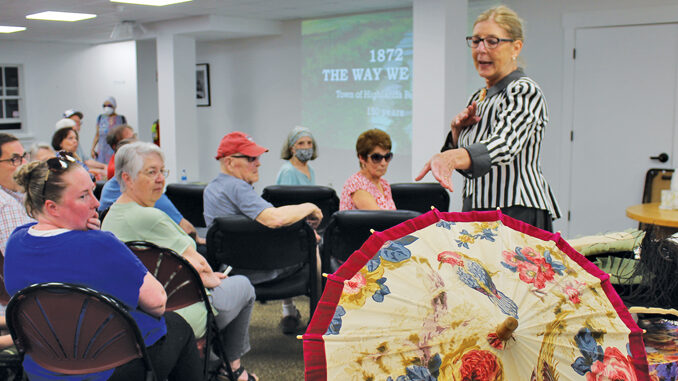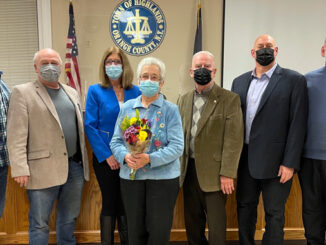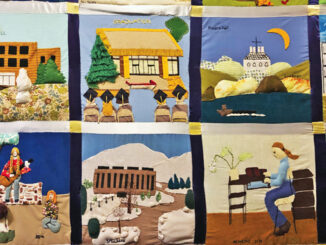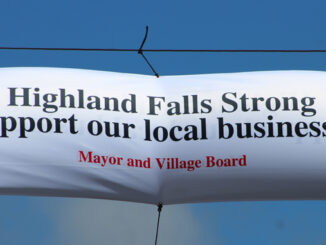
Historian Coffey gave talk on what things were like back then
About three dozen people got out of the hot sun and high temperatures on Saturday afternoon to take a walk back in time at the Highland Falls Library.
They walked back about 150 years, to be exact … to the year 1872!
The event was a talk entitled ‘The Way We Were’, given by Highlands Historian and Historical Society President Ronnie Coffey as part of her tribute to the 150th anniversary of the Town of Highlands. It was in 1872 that Highlands separated from Cornwall, a move, she said, that made sense because of “communication and transportation” difficulties between the two halves of one town — with the very large Storm King Mountain sitting in between them.
The well-attended event was one of several events Coffey has planned — a tour of local churches has already taken place, two arts & crafts events are coming up in the summer months, and a July 4 ‘historical pub crawl’ fundraiser.
Saturday’s talk began with a quiz of sorts — Coffey had old items such as wooden ice skates, a hat stretcher, a spittoon, a nutcracker, hair curlers, and sock mending apparatus on display and she’d challenged those in the audience to figure out what some of them were. She also had, on loan from the Constitution Island Association, several dresses worn by women from that time period; all agreed on a hot spring day such as Saturday they would have been quite uncomfortable.
Coffey was dressed in period garb too, but the indoor air conditioning kept her cool. Air conditioning — and the electricity it takes to operate it — was one of the first things Coffey spoke about as she talked about the nation in 1872, less than ten years after the Civil, War had ended.
“There was no electricity,” she said, “no refrigeration, no paved roads and no really tall buildings. The bicycle had been invented, but was not in common use. There were no voting rights for women — although, Susan B. Anthony was arrested that year for voting in New York State for president; she never paid her fine, God bless her!”
Ulysses S. Grant was president, and cadets graduating from the U.S. Military Academy at West Point were on their way to fight “the Indian Wars” in the west.
“The first generation of Buffalo Soldiers were there too,” Coffey said. “They didn’t arrive at West Point until about 1910.”
In 1872 a popular book was ‘Around the World in 80 Days’ by Jules Verne; Vaseline was invented in New York State (it was a “gook that collected on machinery that, interestingly was found to heal burns,” she said), and cream cheese originated in Chester by a man named William Taylor.
In New York City, the Brooklyn Bridge (then called the Great East River Bridge) was being built, and the Hudson River was “the superhighway” of the time. She said it’s documented that Consti-tution Island’s Anna and Susan Warner sat and counted 200 boats passing by their home one day.
“But mostly, transportation in 1872 could be summed up by one word,” Coffey said, “horse.”
Scarily, in 1872 there was a “terrible catastrophe” when a flu that affected horses killed or debilitated about half of the horses in the country.
So, specific to Highlands, what was happening in 1872 beside the creation of the new town?
Well, the town was renowned for it’s beauty even back then, with people coming to the area to take a rowboat on the Hudson to see Buttermilk Falls.
There were four significant land-owning families in the community — the Cozzens, the Mearns, the Parrys and the Roes. Coffey showed a map of the village of Highland Falls that kind of divided land between the four. The Parrys were by the river, the Cozzens were everything north of Cozzens Ave., the Mearns were at what is now Mearns Ave. and significantly west, and the Roes were in the area where Roe Park is now. Mr. Mearns was a farmer; Roe was a hotelier; and the Parrys operated a grist mill that “fed people from Manhattan to Albany”.
Coffey told a few other tales of local families, noting that 160 men from the community had gone off to fight the Civil War, and 134 of them came back.
In 1872 the Church of the Holy Innocents and the United Methodist Church building were already standing. There were two bakeries, two dried good stores, a butcher, two (possibly three) grocery stores and a druggist, but, for the most part, residents at that time were “pretty much making or growing what they needed.”
Coffey closed her presentation by noting that while things are very different 150 years later, some things remain the same, like the beauty, the popularity of the Hudson River, and “you can still see four-legged animals on Main St.,” making reference to a camel that walked the main road of the village just last week!



